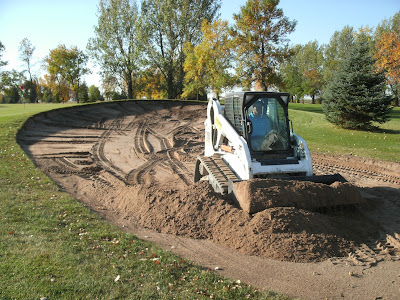I've seen some cluttered shops and work spaces in my day, but the shop here at GFCC had to take the cake as one of the worst. Since I have been here in the last 7 months, I continue to be amazed almost daily at the absolute amount of old JUNK I have come across and thrown away. To list a few of the best: An unopened box of equipment parts (for a piece of equipment that we don't even have any more) that was marked as shipped in 1997. I threw away an old hanging file folder full of the old superintendent's cell phone records that date back to 1996. In the pesticide storage building we were holding onto a box of fungicide that had a lot release date of March of 1995! Items like these were just the tip of the iceberg of the old junk that was taking up space in the shop and making it that much harder to find anything that may actually of been of any value, which I should mention we did find some of those things also. I think in the last 4 months I have hauled close to 6,000 lbs of scrap and junk iron to the steel recycler. At least we got a little money for some of that old stuff....
 |
| An engine that blew up 10 years ago was still collecting dust in the back of the shop. |
I have also been doing my best extreme makeover impression on the office in the shop, which was still decorated with 1982 wallpaper and carpet, and had been heavily smoked in over the years. I gutted the entire thing, scrubbed the walls, and then used the extra cash I had from recycling all the old steel to buy some new paint, carpet, and fixtures to help bring the place into the 21st century. The shop and office is now CLEAN, ORGANIZED, and FUNCTIONAL....a task I have really been wanting to tackle since the first day I stepped foot on GFCC property back in April, just haven't had time to do until now.
On a more interesting note, some of you may have caught some other posts about our current stretch of dry and mild weather this fall. The US Drought Monitor lists the entire Red River Valley as "abnormally dry" on the edge of going into "moderate drought". My weather records for rainfall and temps at the shop combined with some NOAA records show September was 2.4 degrees warmer than average with only 1.15" of precip compared to a normal of 2.05". October was a whopping 7.0 degrees warmer than normal with only .27" of precipitation compared to an average of 1.97". November came in at 5.4 degrees warmer than average with only .15" of precipitation compared to an average of .95". November also saw only 1.2" of snow compared to an average of 7.7" for the month.
All told, the months of Sep, Oct, and Nov. have come in 4.9 degrees warmer than normal and deficient close to 3.5" on precipitation. We also tied or broke a total of eight record high temperatures in those three months as well.
I don't think anyone is complaining about the lack of moisture as it seems to have drastically improved our flood outlook going into next spring, although there is still an awful lot of winter left. What the dry conditions have done however is left the turfgrass, in particular the greens, in a bit of a critical condition going into winter. Although the turfgrass plant is completely dormant at this point, it does still remain alive for the next few months. Just like a hibernating bear, the grass is asleep; but still needs to breathe, hydrate, and use it's energy reserves to stay alive until next spring. The ground is so dry, and the now the lack of snowcover leaves the turf plant susceptible to the brutal, drying effects of the winter wind. Even a small amount of snow cover would make a world of difference for the health of the greens right now.
Needless to say, I am a little concerned on a variety of fronts about the health of some of our greens come next spring. I will also be curious to see the size of some of the cracks that will show up as the frost continues to penetrate deeper into the dry, exposed ground. Let's just hope for a little bit of snowcover soon, followed by a nice, early spring.


























